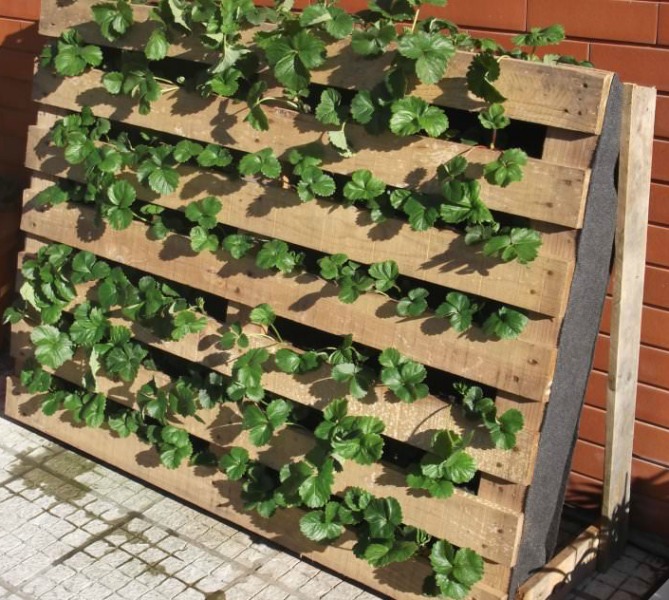Holy Cow! Are we having a blast or what?
Congratulations to all of my Backyard Growers who are on fire with excitement, success and enthusiasm. I promise, this is without a doubt, the most fun you can have with your bibs on!
How to Grow the Most Delicious Strawberries in Your Garden.
Strawberries are easy and fun to grow at home and it’s not as difficult as some people think. One strawberry plant can produce up to a quart of tasty berries.

Source-1001gardens.org
You need good rich soil that is well drained. If your soil tends to be wet and sticky all the time, then build a raised bed with good rich topsoil. You can do this just by dumping some topsoil in your garden and building a low mound, or you can get all fancy and build a tiered planting box.
Make sure your strawberry patch is in full sun. That’s a must.
Strawberry plants wear out. They really only produce berries for two, three or four years then berry production drops way off and they need to be replaced. Furthermore, some strawberry plants shouldn’t be allowed to produce any berries at all the first year you plant them.
More about that in sec!
Basically there are two different kinds of strawberry plants.
-
June Bearing Strawberries.
June bearing strawberry plants don’t start producing berries until June, but they are said to be the sweetest, best tasting berries. But they really need one full growing season before you can expect a crop of berries from them.
In fact, you should plant them in the early spring, then when they start producing flowers you should go through the garden and pinch off all the blooms the first year. That will prevent the plants from producing fruit the first season, and that is essential so they deliver you a bountiful crop in seasons two, three and maybe four.
One of the most popular varieties of June Bearing is Earliglow. It is the earliest blooming of the June Bearing. Other good varieties include Lester, Red Chief and Sure Crop.
-
Day Neutral Strawberries.
Day Neutral strawberry plants will produce a full crop of berries the season that you plant them. But you should still pinch all of the flowers of until about the middle of June, then allow them to produce flowers and berries.
Some people think that Day Neutral Strawberries aren’t as tasty as their June Bearing cousins, but I think they are plenty tasty enough.
Of the Day Neutral berries Tristar and Tribute are good varieties.
However, what you should do, is plant some of both. That way you’ll have berries the first season, and a terrific crop of berries the second, third and fourth seasons. 22 plants total is what I recommend for the average family, buy 11 of each and keep them separate when you plant them so you know which ones to allow fruit production and which ones to keep pinched back the first season.
Make your rows 36″ to 42″ apart and place the plants in the row about 12″ apart. Be careful to not put the plants in too deeply. Make sure the roots are covered without about one inch of soil then keep them watered until they get established.
After all of your berries have been picked you should renovate your strawberry patch. Do this by rototilling between the rows so you end up with a row of berry plants that is only about 12″ wide.
You should also thin the plants in the row so you have at least 4″ to 6″ between the plants. Next trim the tops of the plants so they are no more than a couple of inches high.
Once all of that is done you should keep the berry patch watered as needed so the plants can rejuvenate before winter.
Come winter wait until after two hard freezes and cover your berry plants with straw for winter protection.
When your strawberry plants start to produce blooms in the spring you can protect those blooms from late frosts or freezes by covering the plants or simply going out really early in the morning with the garden hose and rinsing the frost from your berry plants. I know this sounds crazy,
but it works and is used widely by large strawberry growers.
But you have to rinse the frost off before the sun hits the plants. The sun hitting a frost covered strawberry plant is what does the damage.
Okay, that’s enough about strawberries! I don’t want to make your brain hurt.

Source-Illinois.edu
Take care, have a great day and by all means stay inspired!
-Mike McGroarty
The picture shows strawberries in a pallet. You said to start the plants 36 inches apart. Can you do both. I would like to use the pallet if It can be done as shown.
Jennifer, you can do both.
Is there a particular type of straw that you cover your berries with. We covered ours with it this past winter and it went to seed and of course causing quite a mess to clean out of the strawberry beds.
Mike,
Does your frost damage prevention hold good for other crops. We had a surprise frost 3 days ago – damaged the ash trees coming out of bud badly – hostas and geraniums took a hit. Got the sprinkler on at 6am ( sunrise 5.30) and the rest look more or less OK. If I had a “frost alarm arrangement” that enabled watering at say 4.30am have solved the problem ? or is it better to water the night before ?
Edward,
You need to start watering before sun up and water until the danger of frost has past. The goal is to wash the frost off the plants before the sun hits it. And yes, this works for all kinds of plants. Used it last week on everything in my nursery, including hosta that I could see the frost on.